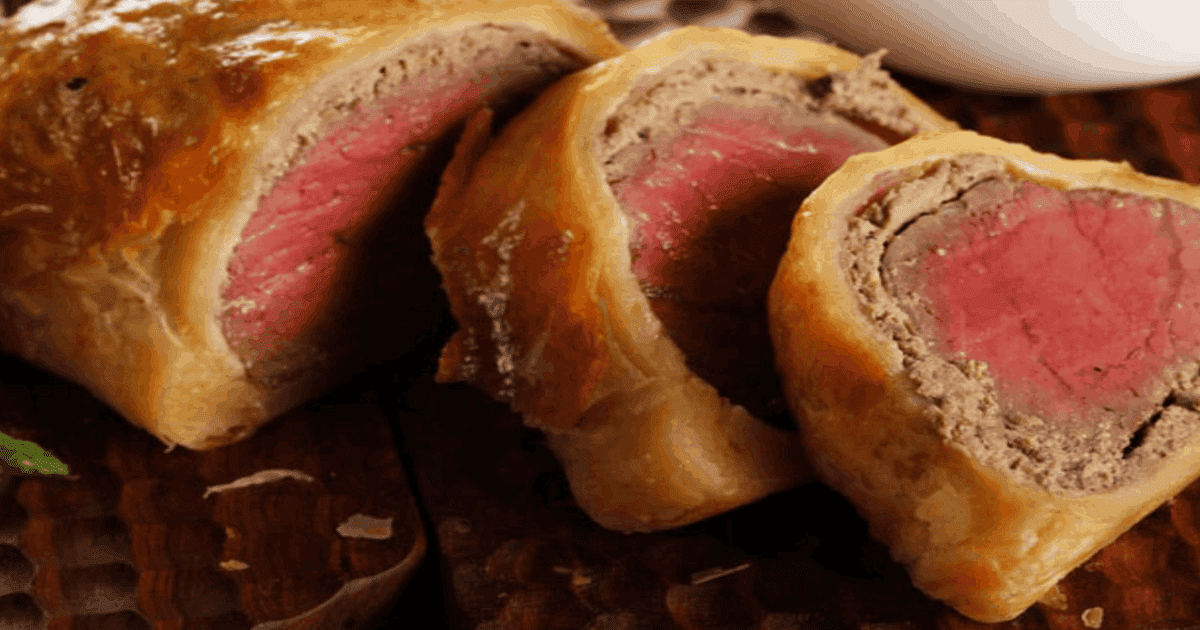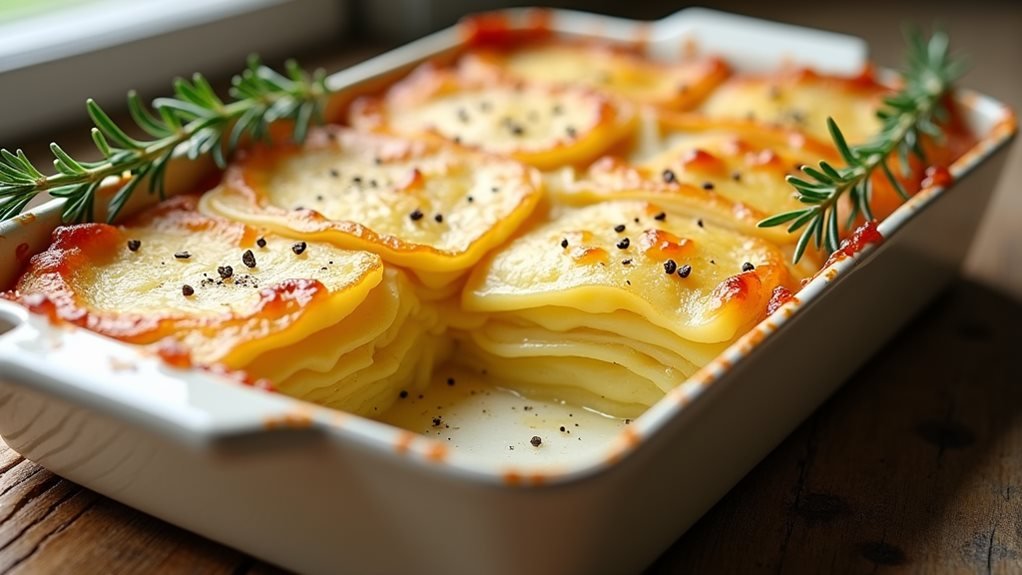The holiday season is filled with warmth, joy, and delicious food. Gordon Ramsay’s luxurious and ever-impressive Holiday Beef Wellington is among the classic dishes that grace many festive tables. This puff pastry beef delight is a savory masterpiece, perfect for special occasions.
Choosing the right cut for your Beef Wellington is crucial; nothing beats the juicy beef tenderloin. Its tender quality forms the centerpiece of this culinary work of art.

Holiday Beef Wellington Recipe
Ingredients
Mushroom Duxelles
- 1 lb. cremini mushrooms, coarsely chopped
- 1 handful Chestnuts
- ½ tsp. Kosher salt
- ¼ tsp. freshly ground black pepper
- 2 tbsp. minced chopped chives
Beef Filet of Wellington
- 2 lb. filet mignon Kosher salt and freshly ground black pepper to taste
- 2 tbsp. canola or grapeseed oil
- ¼ C. whole-grain Dijon mustard
- ½ lb. prosciutto di Parma
- 1 egg yolk
- 1 tbsp. whole milk
Puff Pastry Dough
- 1 sheet of pre-made Puff Pastry Dough.
Instructions
- Quickly sear the beef fillets in a hot pan with olive oil for 30 to 60 seconds until browned all over and rare in the middle. Remove from the pan and leave to cool.
- Finely chop the mushrooms with chestnuts and fry in a hot pan with olive oil, thyme leaves, and some seasoning. When the mushrooms begin to release their juices, cook over high heat for about 10 minutes until all the excess moisture has evaporated and you are left with a mushroom paste (known as a duxelles). Remove the duxelle from the pan and leave it to cool.
- Cut the pastry in half, place it on a lightly floured surface, and roll each piece into a rectangle large enough to envelop one of the beef fillets. Chill in the refrigerator.
- Lay a large sheet of cling film on a work surface and place 4 slices of Parma ham in the middle, overlapping them slightly, to create a square. Spread half the duxelle evenly over the ham.
- Season the beef fillets, then place them on the mushroom-covered ham. Using the cling film, roll the Parma ham over the beef and tie the cling film to get a nice, evenly thick log. Repeat this step with the other beef fillet, then chill for at least 30 minutes.
- Brush the pastry with the egg wash. Trim the pastry and brush all over with the egg wash. Cover with cling film and chill for at least 30 minutes. Remove the cling film from the beef, then wrap the pastry around each ham-wrapped fillet.
- Meanwhile, make the red wine sauce. Heat the oil in a large pan, then fry the beef trimmings for a few minutes until browned on all sides. Stir in the shallots with the peppercorns, bay, and thyme and continue to cook for about 5 minutes, frequently stirring, until the shallots turn golden brown.
- Pour in the vinegar and let it bubble for a few minutes until almost dry. Now add the wine and boil until nearly entirely reduced. Add the stock and bring it to a boil again. Lower the heat and simmer gently for 1 hour, removing any scum from the surface of the sauce until you have the desired consistency. Strain the liquid through a fine sieve lined with muslin. Check for seasoning and set aside.
- When you are ready to cook the beef wellingtons, score the pastry lightly and brush it with the egg wash again, then bake it at Bake for approximately 35 minutes at 425°F until the pastry is golden brown cooked. Rest for 10 minutes before carving.
- Meanwhile, reheat the sauce. Serve the beef wellingtons sliced, with the sauce as an accompaniment.
Video
Notes
What cut of beef is best for Beef Wellington?
The best cut of beef for Beef Wellington is the beef tenderloin, particularly the center-cut portion known as the Chateaubriand. This cut is prized for its tenderness and mild flavor, which pairs well with the rich flavors of the duxelles (mushroom mixture) and pâté that traditionally accompany the dish.
Is Beef Wellington a good Christmas dinner?
Yes, Beef Wellington is an excellent choice for Christmas dinner. It is a luxurious and festive dish that is sure to impress guests. Its elegance and the fact that it can be prepared beforehand make it a great option for a special holiday meal where you want to spend time with family and friends rather than being busy in the kitchen.
How do you make Beef Wellington without a soggy bottom?
To prevent a soggy bottom on your Beef Wellington, you can:
- Ensure the beef is seared and cooled before wrapping to minimize moisture.
- Wrap the beef in a layer of prosciutto or Parma ham before the duxelles to create a barrier that prevents moisture from reaching the pastry.
- Chill the assembled Wellington before baking to firm up the pastry.
- Cook the Wellington at a high temperature so that the pastry quickly sets.
- Place the Wellington on a preheated baking tray or pizza stone to start cooking the bottom crust immediately.
- Some chefs recommend brushing the inside of the pastry with egg wash or mustard, which can create a protective layer.
What is traditionally served with Beef Wellington?
Traditionally, Beef Wellington is served with sides that complement its rich flavors. Common accompaniments include:
- Roasted vegetables such as carrots, parsnips, or Brussels sprouts
- Potatoes, either roasted, mashed, or in dauphinoise form
- Green vegetables like steamed asparagus or green beans
- Red wine sauce, Madeira sauce or a Gooseberry Sauce for added depth and moisture
- Truffle oil or shaved truffles for a luxurious finish
Each side balances the dish through earthiness, freshness, or acidity.
Summing Up
As the last tendrils of steam rise from the golden pastry, bringing with it a bouquet of robust, meaty aromas and the subtler notes of earthy mushrooms and herbs, it is clear that this Gordon Ramsay Holiday Beef Wellington carries on the tradition of festive indulgence. Embracing this dish, with the tenderloin enrobed in its crisply layered shroud, is to partake in a culinary ritual as time-honored as the holiday itself.
But it is more than tradition we pay homage to when this masterpiece graces our table; we celebrate the passion of cooking, the joy of sharing a perfectly crafted meal, and the universal language of flavors that need not words for articulation. This Beef Wellington, a culmination of finesse, technique, and the finest ingredients, ensures a holiday experience that lingers on the palate and in our memories long after the plates have been cleared.







